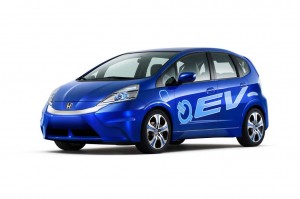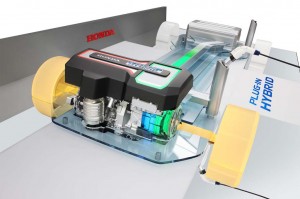Honda will roll out a pair of new prototypes at the upcoming Geneva Motor Show meant to underscore the maker’s new commitment to battery propulsion. Until recently, the automaker was earning a reputation for recalcitrance, dismissing lithium-ion technology in favor of older, more limited hybrids and hydrogen power.
The star of the Honda stand at the PALExpo convention center will likely be a prototype Honda Fit EV, which the maker intends to bring to market in 2012 – and use to directly challenge its Japanese rival, Nissan, which recently launched the Leaf, the world’s first mass-production battery-electric vehicle.
“The Honda EV Concept hints strongly at the direction and styling for Honda’s upcoming production battery electric vehicle, the Fit EV, which will be introduced to the U.S. and Japan in 2012,” said a statement from the Japanese maker, which referred to the battery car as intended “to meet the daily driving needs of the average metropolitan commuter.”
Honda has long dismissed lithium-ion technology as limited in application and too costly for the mass market. Instead, the maker has steadfastly stuck with its “mild hybrid” IMA drivetrain, which relies on less powerful but well-tested nickel-metal hydride batteries. Longer-term, Honda has contended that the future is in hydrogen power – as used in the fuel-cell-powered Honda FCX Clarity.
But the maker began to reverse course when, at last November’s Los Angeles Motor Show, CEO Takanobu Ito unveiled an early battery car prototype, and declared, “Our ultimate goal is to power personal mobility with electricity.”
Like the Leaf, the production version of the Honda Fit EV is expected to get about 100 miles per charge of its lithium-ion batteries – the pack expected to be in the 24 kilowatt-hour range.
But unlike the Nissan battery car, which features a specially designed platform and body, Honda has chosen to go with a modified version of its existing Fit subcompact. That may reflect the maker’s relatively late conversion to lithium technology and its desire to get the Fit EV to market as soon as possible.
The battery car will sit alongside a new plug-in hybrid platform. That system will feature a more advanced, lithium-based drivetrain than the IMA system currently in use in products like the Honda Insight. Among other things, it will permit a vehicle to be driven solely on either gasoline or electric power – or a blend of both.
Unlike the new Chevrolet Volt plug-in – which General Motors prefers to call an “extended-range electric vehicle” – the Honda plug-in will use its gas engine as a direct part of the driveline. With Volt, the I4 engine is nominally operating as a generator, only adding some direct torque under heavy load conditions.


